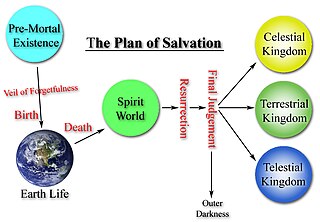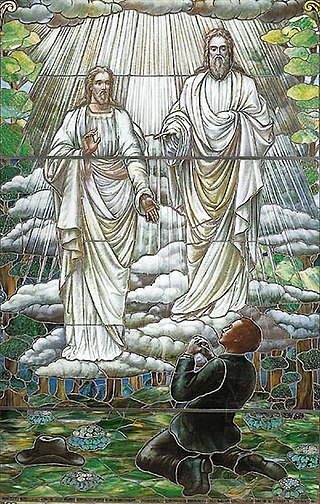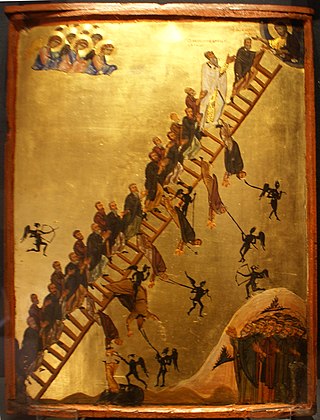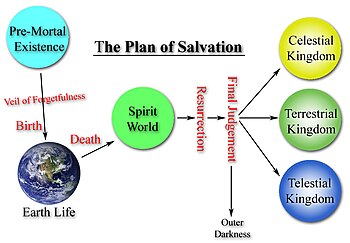
The Last Judgment, Final Judgment, Day of Reckoning, Day of Judgment, Judgment Day, Doomsday, Day of Resurrection or The Day of the Lord is a concept found across the Abrahamic religions and the Frashokereti of Zoroastrianism.
The Adam–God doctrine was a theological idea taught in mid-19th century Mormonism by Brigham Young, a president of the Church of Jesus Christ of Latter-day Saints. Although the doctrine is rejected by the LDS Church today, it is still an accepted part of the modern theology of some Mormon fundamentalists.

In the Latter Day Saint movement, the Heavenly Mother, also known as the Mother in Heaven, is the mother of human spirits and the wife of God the Father. Collectively Heavenly Mother and Father are called Heavenly Parents. Those who accept the Mother in Heaven doctrine trace its origins to Joseph Smith, founder of the Latter Day Saint movement. The doctrine became more widely known after Smith's death in 1844.

The Church of Jesus Christ is an international Christian religious denomination headquartered in Monongahela, Pennsylvania, United States. Organized at Green Oak, Pennsylvania, U.S.A. in the year 1862. The church is a Christian Restorationist church and accepts the Book of Mormon as scripture. The church considers itself the gospel restored, or the original church and good news as established by Jesus Christ in the New Testament, restored upon the earth. It also claims to be the spiritual successor to the Church of Christ, organized by Joseph Smith on April 6, 1830. The church sees Sidney Rigdon as Smith's rightful successor following the assassination of Smith because Rigdon was Smith's first counselor in the First Presidency. The church is not officially affiliated with any other church, organization or denomination.
Agency, in the theology of the Church of Jesus Christ of Latter-day Saints, is "the privilege of choice which was introduced by God the Eternal Father to all of his spirit children in the premortal state". Mortal life is viewed as a test of faith, where our choices are central to the plan of salvation in Latter-day Saint teaching. "It was essential for their eternal progression that they be subjected to the influences of both good and evil". LDS Church members believe that Lucifer rebelled against the God's plan, which resulted in a war in heaven, and Lucifer being cast out of heaven and becoming Satan.

Celestial marriage is a doctrine that marriage can last forever in heaven. This is a unique teaching of the Church of Jesus Christ of Latter-day Saints and branches of Mormon fundamentalism.
The conditional preservation of the saints, or conditional perseverance of the saints, or commonly conditional security, is the Arminian Christian belief that believers are kept safe by God in their saving relationship with him upon the condition of a persevering faith in Christ. Arminians find the Scriptures describing both the initial act of faith in Christ, "whereby the relationship is effected", and the persevering faith in him "whereby the relationship is sustained." The relationship of "the believer to Christ is never a static relationship existing as the irrevocable consequence of a past decision, act, or experience." Rather, it is a living union "proceeding upon a living faith in a living Savior." This living union is captured in the simple command by Christ, "Remain in me, and I in you".

In the theology and cosmology of The Church of Jesus Christ of Latter-day Saints, in heaven there are three degrees of glory which are the ultimate, eternal dwelling places for nearly all who have lived on earth after they are resurrected from the spirit world.
A spirit body is, according to the Church of Jesus Christ of Latter-day Saints, the organization of a spiritual element, made into the spiritual form of man, which was made in the same likeness of God the Father. This likeness apparently gave rise to the phrase and meaning of, "like father like son," which means the son is in the likeness of the father, which provides meaning to the claim that humanity was made in the likeness of God. Generally, people in the West have commonly used the word "soul" to denote this spirit body.

The New Church can refer to any of several historically related Christian denominations that developed under the influence of the theology of Emanuel Swedenborg (1688–1772). The Swedenborgian tradition is considered to be a part of Restorationist Christianity.
The Church of Jesus Christ of Latter-day Saints teaches that Adam and Eve were the first man and the first woman to live on the earth and that their fall was an essential step in the plan of salvation. Adam in particular is a central figure in Mormon cosmology.

The War in Heaven was a mythical conflict between two groups of angels in traditional Christian cosmology, attested in the Book of Revelation alongside proposed parallels in the Hebrew Bible and the Dead Sea Scrolls. It is described as the result of the Archangel Satan rebelling against God and leading to a war between his followers and those still loyal to God, led by the Archangel Michael. Within the New Testament, the War in Heaven provides basis for the concept of the fallen angels and for Satan's banishment to Christian Hell. The War is frequently featured in works of Christian art, such as John Milton's epic poem Paradise Lost, which describes it as occurring over the course of three days as a result of God the Father announcing Jesus Christ as His Son.

Mormon cosmology is the description of the history, evolution, and destiny of the physical and metaphysical universe according to Mormonism, which includes the doctrines taught by leaders and theologians of the Church of Jesus Christ of Latter-day Saints, Mormon fundamentalism, the Restoration Church of Jesus Christ, and other Brighamite denominations within the Latter Day Saint movement. Mormon cosmology draws from Biblical cosmology, but has many unique elements provided by movement founder Joseph Smith. These views are not generally shared by adherents of other Latter Day Saint movement denominations who do not self-identify as "Mormons", such as the Community of Christ.
Members of the Church of Jesus Christ of Latter-day Saints and other adherents in the Latter Day Saint movement, believe that there will be a Second Coming of Jesus Christ to the earth sometime in the future. The LDS Church and its leaders do not make predictions of the actual date of the Second Coming.

The Church of Jesus Christ of Latter-day Saints focuses its doctrine and teaching on Jesus Christ; that he was the Son of God, born of Mary, lived a perfect life, performed miracles, bled from every pore in the Garden of Gethsemane, died on the cross, rose on the third day, appeared again to his disciples, and now resides, authoritatively, on the right hand side of God. In brief, some beliefs are in common with Catholics, Orthodox and Protestant traditions. However, teachings of the LDS Church differ significantly in other ways and encompass a broad set of doctrines, so that the above-mentioned denominations usually place the LDS Church outside the bounds of orthodox Christian teaching as summarized in the Nicene Creed.
In the Church of Jesus Christ of Latter-day Saints, a son of perdition is a person who will not take part in the glory of God in the afterlife. This is in contrast to the vast majority of people, who will receive a "kingdom of glory" after the Final Judgment, and enter into one of three degrees of glory after the resurrection: celestial, terrestrial, or telestial kingdoms.

In Christianity, heaven is traditionally the location of the throne of God and the angels of God, and in most forms of Christianity it is the abode of the righteous dead in the afterlife. In some Christian denominations it is understood as a temporary stage before the resurrection of the dead and the saints' return to the New Earth.
Exaltation is a belief in Mormonism that after death some people will reach the highest level of salvation in the celestial kingdom and eternally live in God's presence, continue as families, become gods, create worlds, and make spirit children over whom they will govern. In the largest Mormon denomination, the Church of Jesus Christ of Latter-day Saints, top leaders have taught God wants exaltation for all humankind and that humans are "gods in embryo". A verse in the LDS Church's canonized scripture states that those who are exalted will become gods, and a 1925 statement from the church's highest governing body said that "All men and women are in the similitude of the universal Father and Mother ... [and are] capable, by experience through ages and aeons, of evolving into a God."
Heavenly Parents is the term used in Mormonism to refer collectively to the divine partnership of God the Father and the Heavenly Mother who are believed to be parents of human spirits. The concept traces its origins to Joseph Smith, the founder of the Latter Day Saint movement.
The concept of premortal life in the Latter Day Saint movement is an early and fundamental doctrine which states that all people existed as spirit bodies before coming to Earth and receiving a mortal body. In Mormonism's eponymous text, the Book of Mormon, published in 1830, the premortal spirit of Jesus Christ appears in human form and explains that individuals were created in the beginning in the image of Christ. In 1833, early in the Latter Day Saint movement, its founder Joseph Smith taught that human souls are co-eternal with God the Father just as Jesus is co-eternal with God the Father, "Man was also in the beginning with God. Intelligence, or the light of truth, was not created or made, neither indeed can be."









